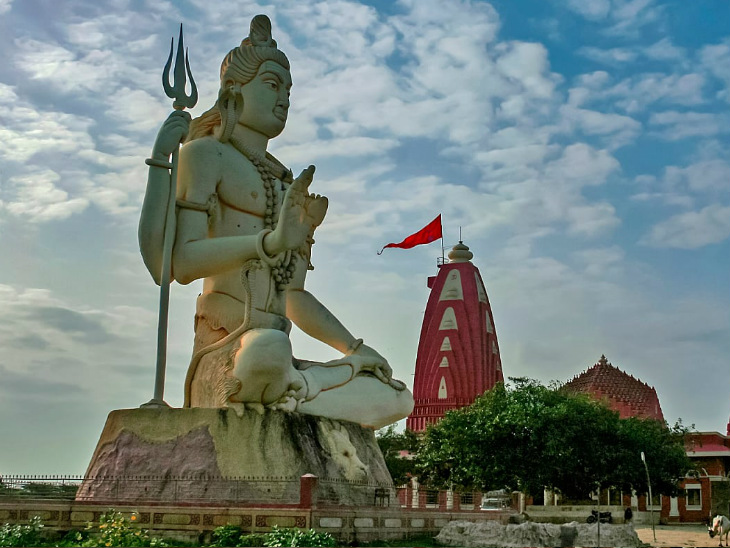The salty tang of the Arabian Sea hits you before you see the temple. As you approach Nageshwar Jyotirlinga Temple through the coastal village of Dwarka in Gujarat, the sound of crashing waves mixes with temple bells in a rhythm that’s both ancient and immediate. Unlike the hilltop temples I’ve visited, Nageshwar sits at sea level, its foundation grounded in the same earth that the ocean constantly reshapes.
The moment you step onto the temple grounds, the temperature drops noticeably. The cool marble floor feels different beneath bare feet—not just smooth stone, but something that’s absorbed centuries of ocean air. The scent isn’t just incense and flowers, but a distinct saltiness that reminds you this Jyotirlinga exists in constant conversation with the sea.
What immediately stands out is how the temple faces the water. While most Shiva temples face east toward the rising sun, Nageshwar looks west—directly toward the setting sun and the endless Arabian Sea. This orientation isn’t accidental; it’s central to the temple’s identity and purpose.
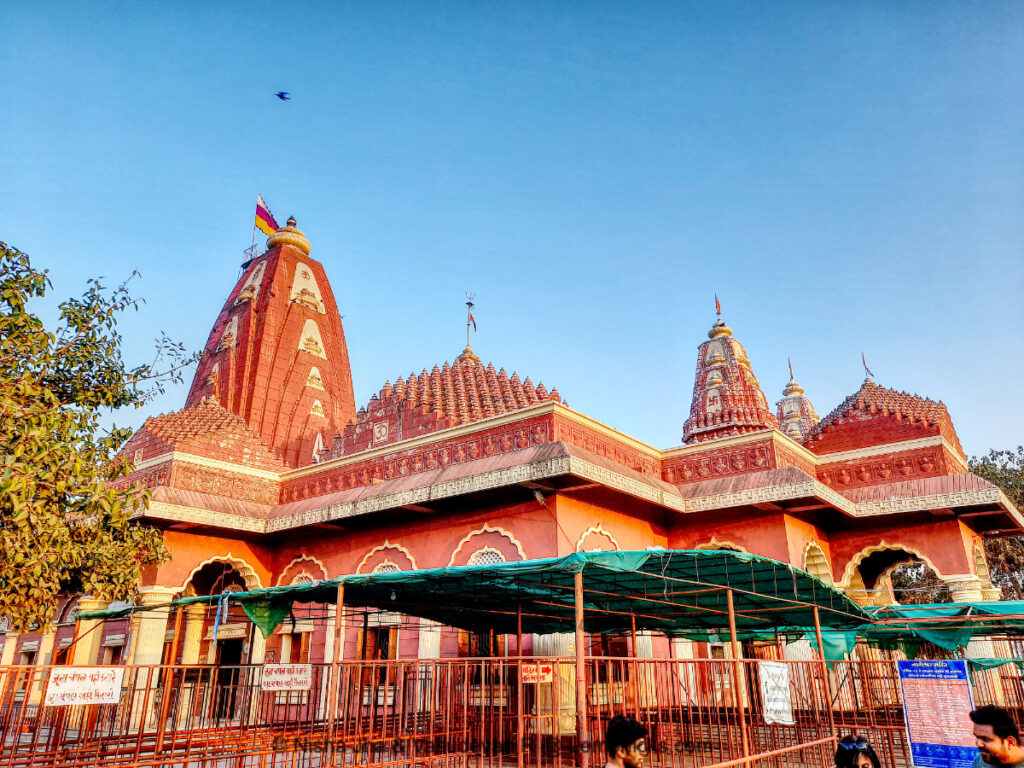
The Historical Timeline: Nageshwar Jyotirlinga Temple
Nageshwar’s history isn’t wrapped in legend alone—it’s documented through archaeological evidence and historical records. The current structure, while built in the 20th century, stands on foundations that date back centuries.
Key historical markers:
- Early references: Mentioned in the Skanda Purana as one of the original twelve Jyotirlingas
- 12th century: Evidence of a temple structure during the Solanki dynasty rule
- 14th century: Destroyed during Alauddin Khilji’s invasion of Gujarat
- 18th century: Rebuilt by the Maratha general Ranoji Shinde
- 1965: Current structure completed under the guidance of Dinshahji Petit
Unlike Somnath which was rebuilt multiple times in the same location, Nageshwar’s exact historical location has been debated. Modern scholarship suggests the original site was about 20 km from the current temple, near the small village of Awa-Dwarka. The current location was established in the 20th century after extensive research by historians and religious scholars.
The temple’s architecture reflects this layered history. The main shikhara (tower) follows the Māru-Gurjara style typical of Gujarat temples, but with adaptations for the coastal environment—thicker walls to withstand sea winds, elevated foundations to protect against high tides, and special stone treatments to resist salt erosion.
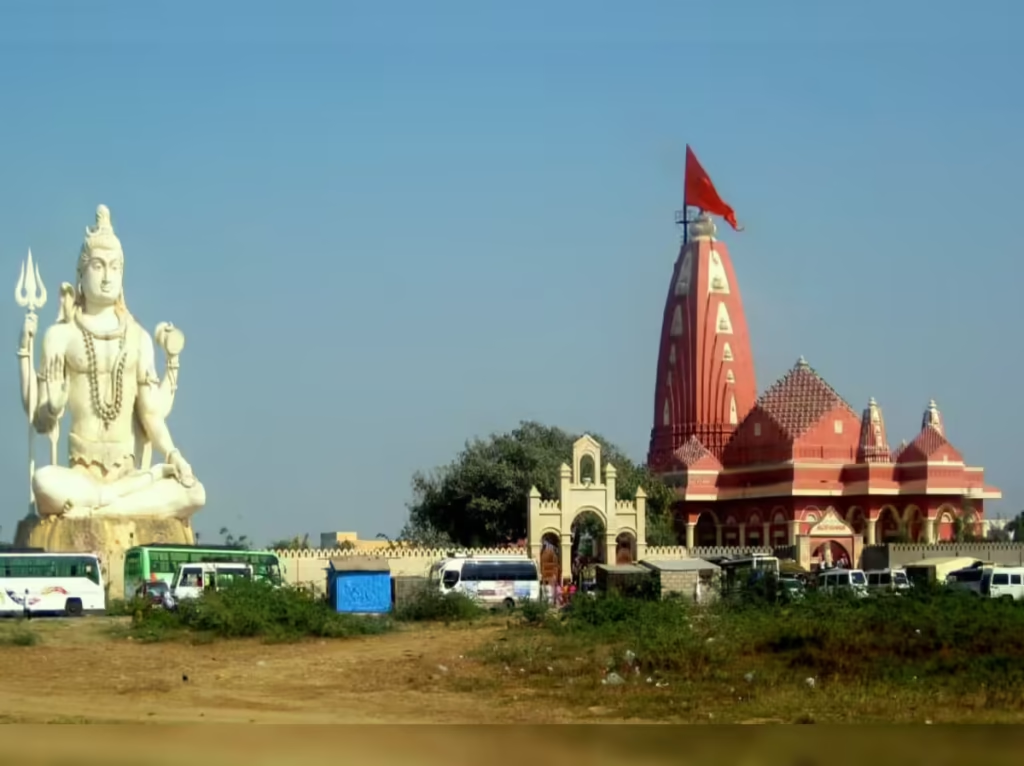
The Serpent Connection: More Than Just a Name
Nageshwar’s name—Naga (serpent) + Ishwar (lord)—isn’t just symbolic. This Jyotirlinga has a specific connection to serpent worship that’s physically present in the temple’s layout and rituals.
What makes this connection tangible:
- Nag Kund: A natural spring on the temple grounds believed to be inhabited by serpents
- Sarpa Mandap: A dedicated hall with over 100 carved serpent motifs
- Naga Puja: Daily rituals specifically honoring serpent deities
- Sarpa Dosha remedies: Special prayers for those seeking relief from serpent-related astrological issues
During my visit, I observed the morning ritual where priests offer milk directly into Nag Kund. What surprised me was the specific timing—they perform this ritual during the “Rahu Kalam” period, considered inauspicious for most activities but ideal for serpent-related worship.
The temple’s location near the ocean is also significant in serpent mythology. In Hindu cosmology, the cosmic serpent Shesha supports the earth on the primordial ocean. Nageshwar’s coastal position physically embodies this concept—the Jyotirlinga standing where land meets the cosmic waters.
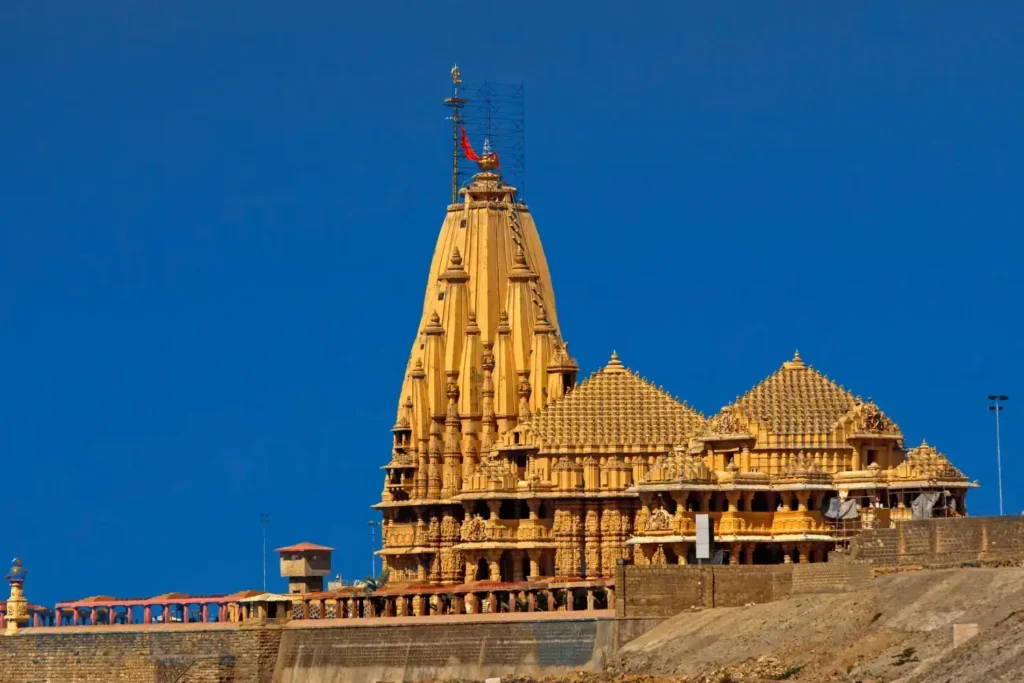
The Architecture: Built for the Sea
Nageshwar’s design reflects its unique coastal environment in ways most inland temples don’t need to consider. The temple isn’t just a spiritual space; it’s an engineering solution to living with the ocean.
Key architectural features:
- Elevated foundation: Raised 1.5 meters above ground level to protect against high tides
- Ventilation system: Strategically placed openings that allow sea breezes to circulate while preventing salt buildup
- Stone selection: Special sandstone from the Bhuj region that resists salt erosion
- Drainage channels: Designed to handle monsoon rains without damaging the structure
- Orientation: Positioned to maximize protection from the strongest sea winds
What most visitors don’t notice is how the temple’s layout follows Vastu Shastra principles adapted for coastal conditions. The main sanctum faces west (unusual for Shiva temples), but the entry gate faces northeast—a compromise that allows for both spiritual alignment and protection from the dominant southwest monsoon winds.
During high tide, the sound of waves becomes part of the temple’s natural acoustics. I timed my visit to coincide with high tide and was struck by how the crashing waves seemed to sync with the temple bells—a natural rhythm that’s been part of Nageshwar’s spiritual experience for centuries.
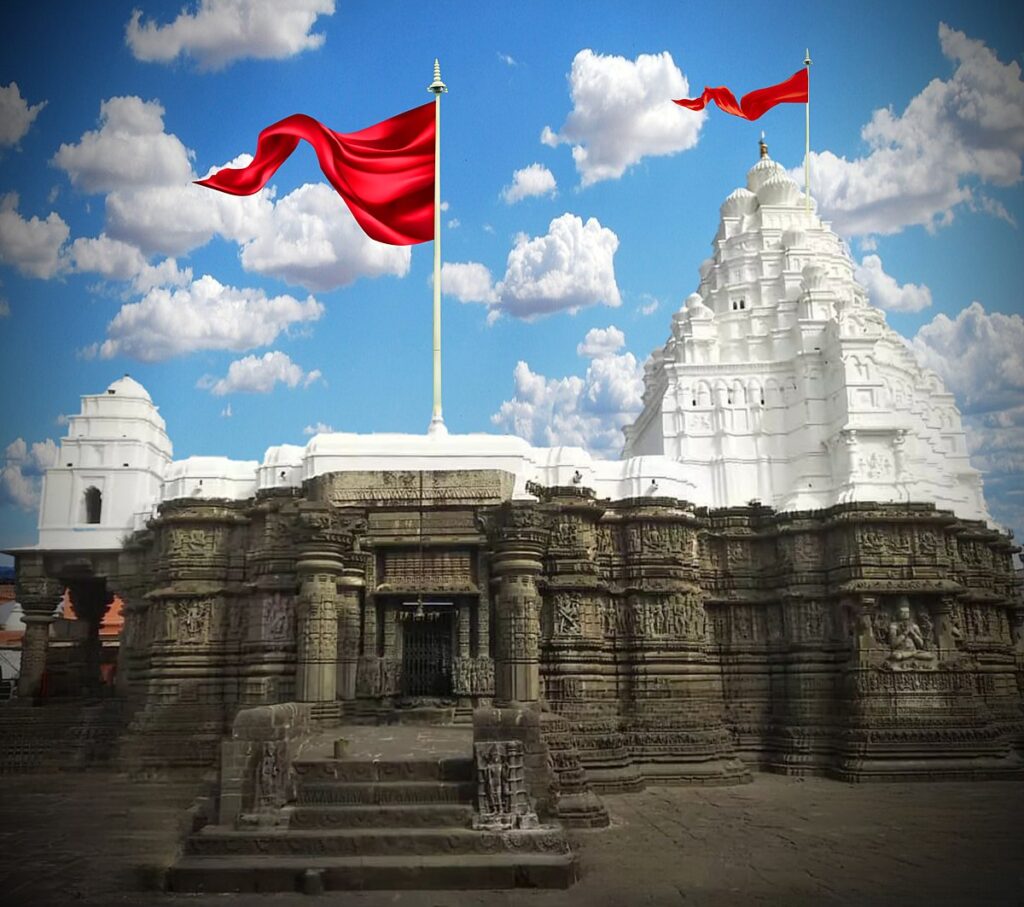
The Rituals: Ocean-Inspired Worship
Nageshwar’s daily rituals incorporate elements you won’t find at other Jyotirlinga temples, all shaped by its coastal location.
Unique ritual elements:
- Jal Abhishekam: The lingam is bathed with seawater collected at specific tidal points
- Conch shell offerings: Thousands of conch shells line the temple walls, each representing a devotee’s prayer
- Tide-based timing: Certain rituals are scheduled according to tidal patterns rather than clock time
- Monsoon special puja: A unique ceremony during the rainy season when the sea is most active
The most distinctive ritual is the “Samudra Aarti” performed during high tide. Unlike the more famous Ganga Aarti at Varanasi, this ceremony happens right at the water’s edge, with priests offering lamps directly to the sea. The timing is precise—exactly when the highest wave of the tide reaches its peak.
I spoke with a temple priest who explained the scientific basis behind these ocean-connected rituals: “The high tide brings minerals from the deep sea that purify the water. We time our rituals to harness this natural purification process.” This practical understanding of coastal ecology woven into spiritual practice is characteristic of Nageshwar’s approach to worship.

The Nag Kund: Where Myth Meets Geology
The natural spring known as Nag Kund isn’t just a ritual site—it’s a geological feature that explains why this location became sacred in the first place. Located about 200 meters from the main temple, this freshwater spring emerges right at the edge of the saltwater ocean.
What makes Nag Kund remarkable:
- It maintains a constant temperature year-round (about 28°C)
- The water is naturally sweet despite being surrounded by seawater
- It never dries up, even during severe droughts
- The spring water contains trace minerals not found in surrounding areas
Geologists believe Nag Kund is part of an underground freshwater aquifer that runs perpendicular to the coast. This rare hydrological feature would have been vital for ancient settlements, explaining why the area became a spiritual center.
During my visit, I tested the water myself—it was noticeably sweeter than regular freshwater, with a slight mineral taste. The temple maintains strict protocols around the spring: no soap or chemicals allowed within 50 meters, and the water is only used for ritual purposes, not consumption.

Practical Visitor Information: What You Need to Know
Planning a visit to Nageshwar requires specific considerations you won’t find at most temples:
Getting There
- Nearest airport: Diu Airport (90 km away)
- Nearest railway station: Dwarka (22 km from the temple)
- Road access: Well-connected via NH51, but monsoon season (July-September) can cause road closures
- Best approach: Take a local auto-rickshaw from Dwarka town—the last 5 km is narrow and best navigated by those familiar with the route
Temple Hours
- Morning: 6:00 AM – 1:00 PM
- Evening: 3:00 PM – 9:00 PM
- Special note: The temple closes during high tide for about 45 minutes—check tide schedules in advance
What to Bring
- Waterproof sandals (the temple grounds can get wet from sea spray)
- Light cotton clothing (the coastal heat can be intense)
- Small towel (for the natural mist from the ocean)
- Cash in small denominations (card payments not accepted)
Unique Experiences
- Samudra Aarti: Witness the sea-facing ritual (timing varies by tide)
- Nag Kund visit: Best experienced early morning when the water is calmest
- Conch shell collection: Participate in the tradition of offering conch shells
- Coastal parikrama: Walk the 3-km circumambulation path along the shore
How Nageshwar Differs from Other Jyotirlingas
Nageshwar stands apart from the other eleven Jyotirlingas in concrete ways:
- Coastal location: Only Jyotirlinga situated directly on the ocean
- Serpent focus: The only one specifically connected to naga (serpent) worship
- Tidal influence: Rituals timed to ocean tides rather than just solar cycles
- Architectural adaptations: Built specifically to withstand coastal conditions
- Water source: Uses seawater for abhishekam, unlike other temples that use river water
What’s particularly distinctive is how Nageshwar’s spiritual significance is tied to practical coastal living. The temple isn’t just a place of worship; it’s a center for understanding the relationship between humans and the ocean—a relationship that’s been vital for the survival of coastal communities for millennia.
During my visit, I met local fishermen who explained how they incorporate temple rituals into their work: “Before we set out to sea, we visit Nageshwar. The priests bless our nets, and we offer the first catch to the temple.” This integration of daily livelihood with spiritual practice is more pronounced here than at inland temples.
Preservation Challenges and Efforts
Nageshwar faces unique preservation challenges that most inland temples don’t encounter:
- Salt erosion: Constant exposure to salt air wears down stone carvings
- Monsoon damage: Annual heavy rains test the temple’s structural integrity
- High tide impacts: Rising sea levels threaten the temple’s foundation
- Tourist pressure: Increased visitation strains the delicate coastal ecosystem
The temple trust has implemented specific preservation measures:
- Biannual stone treatment: Using natural oils to protect against salt
- Elevated walkways: To prevent foot traffic from eroding the foundation
- Tide monitoring system: To anticipate and prepare for high-impact tides
- Visitor limits: Capping daily visitors during monsoon season
I spoke with a conservation expert working at the site who shared that they’ve developed a special stone treatment using neem oil and beeswax that’s been effective in slowing salt erosion. “We can’t stop the ocean,” they explained, “but we can work with it to preserve this sacred space for future generations.”
Beyond the Temple: The Coastal Ecosystem
Nageshwar isn’t an isolated spiritual site—it’s part of a larger coastal ecosystem that enhances its spiritual significance:
- Marine biodiversity: The waters near Nageshwar are home to over 200 fish species
- Migratory birds: Seasonal visitors that follow ancient patterns
- Coastal vegetation: Special salt-resistant plants used in temple rituals
- Traditional fishing practices: Sustainable methods passed down through generations
What many visitors don’t realize is how the temple actively participates in coastal conservation. The trust runs a small marine conservation center near the temple that educates visitors about protecting the local ecosystem. They’ve also partnered with local fishing communities to promote sustainable practices that align with traditional ecological knowledge.
During my visit, I joined a morning walk with temple volunteers who clean the beach of plastic waste. “The ocean gives us our spiritual home,” one explained. “It’s our duty to protect it.” This practical environmentalism woven into spiritual practice is characteristic of Nageshwar’s approach to modern challenges.
Why Nageshwar Matters Today
In our current era of climate change and environmental uncertainty, Nageshwar offers something particularly valuable—a living example of how humans can coexist with powerful natural forces.
The temple teaches practical lessons about:
- Living with rather than against natural cycles
- Respecting the power of the ocean while finding safety within it
- Preserving cultural heritage in the face of environmental change
- Integrating spiritual practice with ecological responsibility
During my final morning at Nageshwar, I watched as the rising sun hit the temple spire just as the tide reached its peak. In that moment, the connection between spiritual practice and natural cycles became tangible—the temple wasn’t just standing against the ocean, but moving with it in a dance that’s been ongoing for centuries.
Nageshwar isn’t just another stop on a pilgrimage in India. It’s a living testament to the possibility of harmony between humans and the natural world—a harmony that’s increasingly vital in our changing world. The temple doesn’t just survive the ocean’s power; it thrives because of its relationship with that power.
As you plan your visit, remember that Nageshwar offers more than spiritual darshan—it offers a chance to witness and participate in a centuries-old conversation between land and sea, between the human and the divine, between preservation and adaptation. In a world searching for sustainable ways to live with our changing environment, Nageshwar’s wisdom has never been more relevant.
FAQs on Nageshwar Temple
1. Where is Nageshwar Jyotirlinga located?
It is located near Dwarka in Gujarat, India.
2. Why is Nageshwar Temple famous?
It is one of the 12 Jyotirlingas of Lord Shiva, believed to protect devotees from poison and negativity.
3. What is the legend of Nageshwar Jyotirlinga?
The temple is linked to the demon Daruka, whom Shiva defeated to save his devotee Supriya.
4. What is the best time to visit Nageshwar Temple?
October to March is ideal, with Maha Shivaratri being the most important festival.
5. Is Nageshwar Temple part of the Dwarka pilgrimage?
Yes, it is included in the popular Dwarka pilgrimage circuit.
6. What are the temple timings?
The temple is usually open from 6 AM to 9 PM daily.
7. How far is Nageshwar Temple from Dwarka city?
It is about 17 km from Dwarka city.
8. Is photography allowed inside Nageshwar Temple?
Photography is usually restricted inside the sanctum sanctorum.
9. What is the special significance of this Jyotirlinga?
Devotees believe worship here removes fear of poison and negative energies.
10. How can visitors reach Nageshwar Temple?
It is well connected by road from Dwarka; the nearest railway station is Dwarka, and the nearest airport is Jamnagar.

